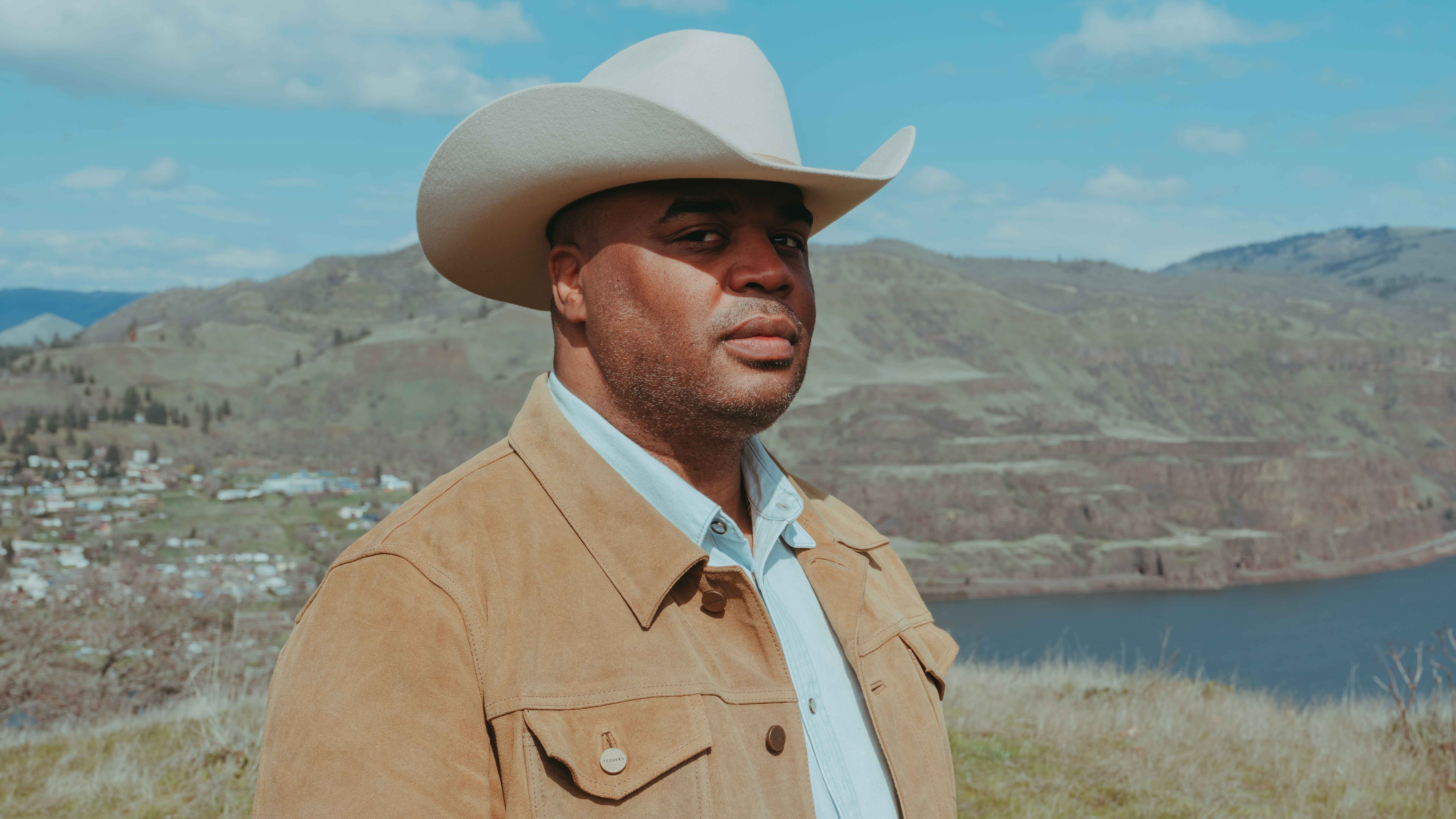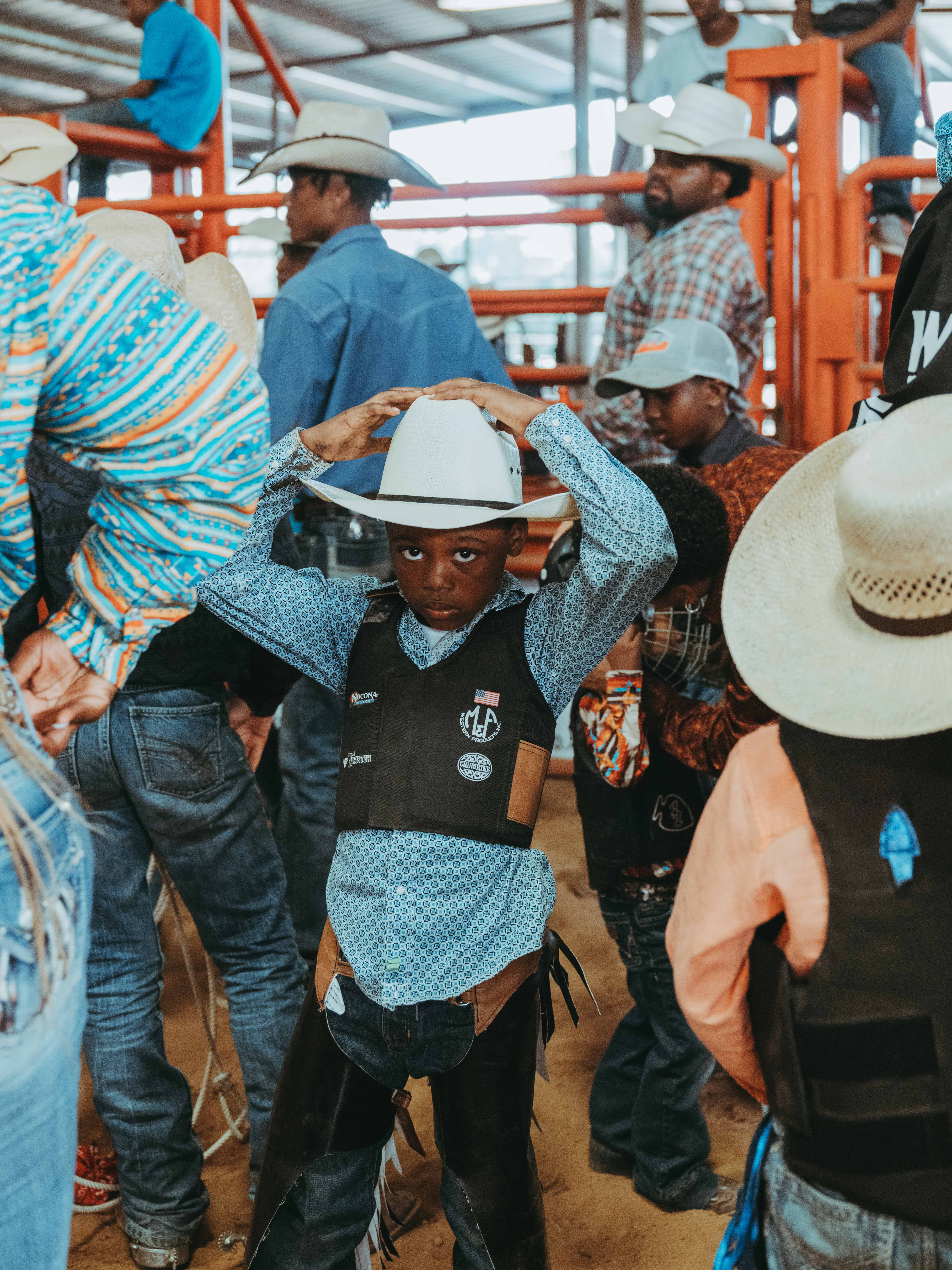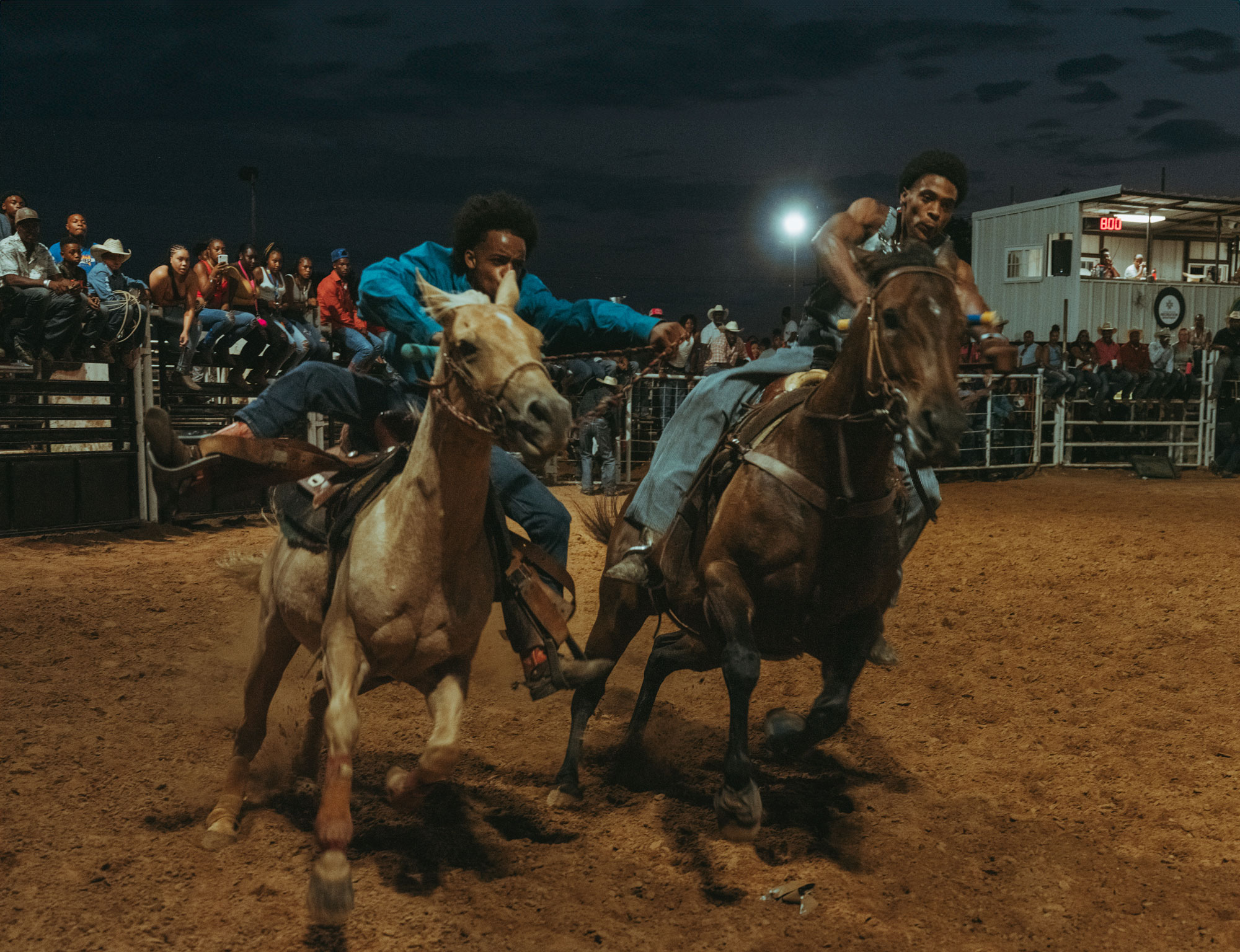
This isn't Ivan McClellan's first rodeo. Over the past decade, the pioneering photographer has propelled the intrepid beauty and once-forgotten history of Black cowboy culture into public consciousness worldwide in a way no one has before.
Braids whip in the wind as long acrylic nails grip the reins of a bronco, hell-bent on galloping around barrels at 50mph. Young cowboys hold hands and pray under a pink haze. They roll up on horses without shirts, wearing diamond stud earrings, gold chains and Jordans. Meanwhile, fellow western folk line-dance to hip-hop, rhythm and blues, and gospel as the smell of fried chicken and barbequed turkey legs swirls up to the beating sun.
The Roy Leblanc Invitational Rodeo in Oklahoma, dubbed ‘the Super Bowl of Black Rodeos’, is America's longest-running Black rodeo. In 2015, it ignited McClellan's passion, many of the powerful shots for his new book, Eight Seconds: Black Cowboy Culture, and changed his life forever.
‘It was 105 degrees. I was walking through snake-infested fields, running away from bulls and climbing over fences all to get a good shot. I went home cut up, covered in dirt, bitten by bugs, and thrilled,’ McClellan beams with a mega-watt smile. ‘There were no other photographers, just me. The athletes and animals were confused about why I was there; no one had paid attention to this world. It really felt like a moment of discovery.’
‘There were no other photographers, just me. The athletes and animals were confused about why I was there; no one had paid attention to this world. It really felt like a moment of discovery’
Ivan McClellan

McClellan's love of cowboys began when he was a young buck. Growing up in Kansas, on five acres of land in the middle of the city, he was introduced to the Wild West through movies like Tombstone and Unforgiven. He also sang the national anthem at the American Royal rodeo with his church choir. Both are some of his fondest memories but also bittersweet.
‘We walked out on the dirt, sang and left because it wasn't a space where we felt we belonged,’ McClellan recounts. ‘As a kid, I loved watching Hollywood cowboys slinging guns, swinging saloon doors, and saying cold-blooded things in ten-gallon hats; they were so exciting. I had seen Black cowboys on TV, but they were always a joke, like Sheriff Bart in Blazing Saddles.’

‘As a kid, I loved watching Hollywood cowboys, but it wasn't a space where we felt we belonged. I had seen Black cowboys on TV, but they were always a joke’
Ivan McClellan
From rodeos to ranches, Nevada to Tennessee, McClellan's photos buck racial stereotypes, celebrate the extraordinary and marginalised and have catapulted Black cowboy culture across the globe.
The roots of African-American cowboy history run deep, and the noble archetype is diverse. Black women and men have been cowboying for 200 years. After emancipation, one in four American cowboys were Black. They moved cattle on horseback, settled towns, kept the peace and played a pivotal role in shaping the iconic culture.
Charles Sampson was the first Black man to win the world championship bull-riding competition. Despite breaking nearly every bone in his body, he bolted into the arena for decades, vaulted himself off the bull, and landed on his feet.
When we speak, McClellan's certainly landed on his. He's dressed in a Compton Cowboys T-shirt (they are a collective, devoted to bettering the lives of inner-city kids) off the back of numerous international press interviews, gearing up for the second Juneteenth rodeo as boss, and on a victory lap for his book, which is sold out across the country.
It's surprising, then, to imagine that McClellan started his career as a wedding, fashion, and landscape photographer. As he moved up the ranks, he noticed that he was surrounded by fewer Black people and felt less inspired.
He carved out a reputation as a street photographer and soon landed an invite to shoot a burgeoning Black cowboy scene.
‘After The Roy Leblanc in Oklahoma, I knew I wanted to shoot rodeo the rest of my life. There were so many different expressions of self. I saw all these horse trailers on the lawn with thousands of Black cowboys who looked so cool, dressed in hip-hop streetwear and crisp classic western style mingling into one. Folks were dancing the Cupid Shuffle. There was this gumbo of familiar sounds and smells with this Black rodeo culture that was so new to me. I felt like I belonged.’
‘I saw horse trailers on the lawn with thousands of Black cowboys who looked so cool, dressed in hip-hop streetwear and crisp classic western style mingling into one’
Ivan McClellan

McClellan was born to shoot rodeo. His outlaw approach behind the lens captures the adrenaline, athleticism and rich sense of camaraderie while bringing you so close to the action you can almost taste the dirt.
One of his most thrilling and evocative shots features on the cover of his new book, and was taken during the Pony Express, a sundown baton relay race, made famous at indigenous rodeos. ‘I'm a little nervous here. I was way too close to the horses, dirt was flying up into my camera, hats were flippin' into the air, but I like to just get in there, and consequences be damned!’ he laughs. ‘The riders were off-kilter, adjusting themselves to me but I snapped the photo and got out of the way. It’s incredibly blurry, technically a mess but it wound up being the cover because it has so much energy. I thought that superseded a perfect photo and really speaks to my process, and [the] experience [of] being at a rodeo.’

The women of the rodeo
When it comes to the magic and culture of rodeo I know that better than most. I was raised around rodeo and attended my first one as soon as I could holler ‘Yeehaw!’
While my father worked with country bands playing at North America’s revered 'Calgary Stampede', I hung out in the barns with fierce cowgirls who hauled quarterhorses across country while all-star cowboys jumped on jets and rode $500,000 horses waiting on the other side. I watched these talented ladies work extra hard to be taken seriously, create legacies, kick down doors for the new wave of female athletes to ride through, and steal the show as barrel racers.
‘I think that's one of the main differences in Black rodeo. The women are far from a sideshow,‘ McClellan proudly declares. ‘If you look at the Bill Pickett Invitational Rodeo, the biggest Black rodeo circuit, the CEO is a female, Valeria Howard-Cunningham, and most of her staff are women. In Black Rodeo, women write a lot of cheques. The barrel-racing competition is super serious. They do a women's version of steer wrestling, and you'll only see it at Black rodeos. There's a women's Pony Express team that's very exciting. It's fierce competition, they're extraordinary athletes, they ride with purpose, and it's the highlight of the rodeo.’

McClellan's book combines portraits, candid shots, a range of emotions within a single day of rodeo life, and powerful women: from a beaming rodeo queen in Okmulgee to a cowgirl named Ja'Dayia Kursh with so much swagger you'd barely notice the dirt on her knee and that she just got bucked off a bronco.
If McClellan's photos aren't proof enough that Black female cowboys are a force to be reckoned with, Beyoncé's lauded country-influenced album Cowboy Carter is cementing their position.
‘It's the perfect alley-oop. Beyoncé is hanging on the rim right now. She's the first Black female to have a No.1 country album. She's not only revealing Black cowboy culture, but she's transforming country music forever and tearing down genres in a way that I don't think has ever been done.’

McClellan even credits his Juneteenth rodeo with reaping the benefits of Queen Bey's foray into country. ‘We sold 7,200 tickets in two months; last week, we sold out. I'm seeing other Black rodeos selling 6,000-8,000 tickets before the rodeo even starts. There is definitely a homecoming culturally of Black folks that never felt like they could wear cowboy boots and a hat and be into rodeo but now have permission to. I hope that catches the attention of the Wranglers, the Boot Barns and the rodeo sponsors of the world – that these Black athletes are packing out arenas and Black rodeo is financially valuable.’
Rodeo is an eye-wateringly expensive sport without a sponsor. Rodeo entry fees, travel, training, and tack are all one thing, and the animals are another. ‘I started my Juneteenth rodeo because many of the Black athletes I was shooting in Oklahoma and Texas were not breaking through to the Pro Rodeo Circuit. I wanted to create a platform where they could get in good reps and get good paycheques.’
Championing his subjects is McClellan's proudest accomplishment thus far.
‘Using photography as a tool to impact lives in a tangible way is what I'm most proud of –elevating people's stories in popular media with my photos and seeing them gain visibility and sponsorship. Being able to pay out $60,000 at my rodeo for athletes to have money to stay on the road for the summer. So that they can upgrade their horses from $10,000 to $100,000, which [is what] most of the top 50 compete on.’

Photographing man and beast
On the topic of the superstar roughstock, McClellan's connection to capturing animals has improved over his nine years in the saddle. ‘I used to be scared of horses, but I love being around them now and learning about their personalities. I love it when a horse is into getting their photo being taken. They start posing, and they might put up a leg, turn, and give you an angle. Some horses really love to pose. They like the attention. That energy is cool. I have a big camera, and the horses get real curious. I've often had horses get all up in my camera before, and bulls, too. Their energy can be a lot of fun.’
Most seasoned rodeo photographers use a long lens and keep on the other side of the fence. Not McClellan; he uses a short lens. ‘The top tip to a good rodeo photo is to get as close to your fear as you possibly can. What are you afraid of? Walk right up to that thing, and that's going to be your best shot. I like to take photos in the arena, in the dirt. It's dangerous and a little stupid, but it's where the best photography is, and nobody else is getting those shots.’

When pressed to sum up why his photos and rodeo are important, McClellan waxes poetic: ‘Rodeo is American tribalism at its core. It's what every culture in America does at its root. It's connected to agriculture, it's connected to food, and it's connected to our highest ideals of ourselves. Mainstream rodeo is the purest form of White culture. Indigenous and Black rodeos are the same. If you go to a Mexican rodeo, people are dancing Cumbia in the arena; there are Modelo cans up to your ankles and a 20-piece band on stage playing at the same time as bull riders are trying to clock eight seconds. It's such a thrill to the senses,’ he continues. ‘I love going to all these different rodeos in all these different spaces.’
As we say goodbye, he riffs about future plans to wrestle his beast of a rodeo and grow old as boss, document other marginalised subcultures and shoot rodeo until the sun goes down.
‘When people come up to me and ask what I do for fun? It's this,’ McClellan says. ‘Photography is my joy. Sitting on a fence on a Friday night and looking at fireflies in the background, eating a turkey leg, drinking a strawberry pop, and laughing with lifelong friends who have become my family – that's what I really love.’







